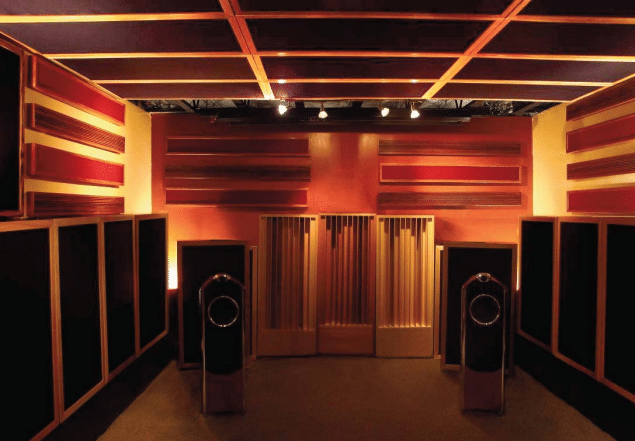Should I use front wall diffusion in my control room? Now the setup he is talking about saw the diffusers on the front wall but they were kind of angled slightly with the speaker stack and the components in the middle.
Well let’s back up a little bit and define what diffusion does. When energy from your room, whether it’s reflected direct from the speakers or any other source, enters the diffuser, the diffuser takes that energy and spreads it out without reducing the time signature or the strength.
So what does a diffuser do?
It interrupts the reflection process. It takes the energy and, depending on the frequency response of the diffuser, the energy is spread out in a more even array distribution within the room, and so we don’t have a reflection that’s more focused and strong.
So that said, is front wall diffusion good?
It depends on the room usage. If you’re in a listening environment, what does diffusion do? When it spreads out that reflected energy, that would have normally struck the wall surface in a more even distribution within the room to your ears and to your brain, you do not localize the boundary surface. Ye do not hear the wall and if you don’t hear the wall your brains think that the room is bigger than it is and that’s a good thing.
Space is always a good thing. Taking a small room and making it sound like a much larger room is a good thing because it adds a dimension to our musical presentation. It makes it more lifelike, it makes it more real.
So in the photo you showed me, we had two dimensions of diffusion. We had quadratic diffusion positioned vertically on the ground on the front wall and then we had above that a horizontal positioning of quadratic diffusion.
Now what does that do?
Quadratic diffusers are one dimensional but when you shift them into different planes you could create two dimensions of diffusion. A vertical diffuser diffuses sound out in a horizontal direction, horizontal fan-like array.
A vertically placed diffuser, diffuses sound horizontally there’s an inverse relationship. A horizontally placed diffuser, diffuses sound vertically. So you have vertical and horizontal and you could achieve two dimensions of diffusion with quadratic diffusion simply by changing the position of the diffuser.
Is two dimensions of diffusion better that one? Yes and No.
There we get into the subjective approach and we get it to room usage. If it’s a listening environment probably better. If it’s a recording studio where it’s a control room, probably not because it impacts a sense of artificiality that maybe the engineer doesn’t want to hear. He doesn’t want the room adding anything to the mix, he just wants the room to go away.
So two dimensions of diffusion can make the room go away if applied correctly but a lot of times will add a little bit more than the engineer wants.
In a listening room, what are our goals?
We want our small room to sound larger? Two dimensions of diffusion on the front wall and the rear wall and even the ceiling can do that, but there again we’re in to that subjective domain. One person likes and thinks it’s good for diffusion. Another person would not want that, he would want maybe a little bit more definition with more absorption.
So we’re in that subjective area but in answer to the question, and a general answer, is two-dimensional diffusion a good idea in listening rooms? Most of the time, I think is the case. Is it necessary and desirable in a control room? No. Probably not the case, although diffusion can be you used on the rear wall of control rooms and commonly is but mainly vertical diffusion.
Years back they used two dimensions of diffusion on the control room rear wall surfaces. That’s not the practice today. Just the one dimension today, the vertical diffusers on the rear wall to break that rear wall slap up at the listening position.
So times have changed a little bit but in a listening room more diffusion is usually better. Remember there’s four acoustical distortions that a room produces and diffusion is one of them.
In Summary
If you want to learn more about this subject please sign up for our free room acoustic treatment videos and ebook which provide step by step instructions on all major room acoustic issues. Get instant access by signing up now.
Thanks
Dennis









